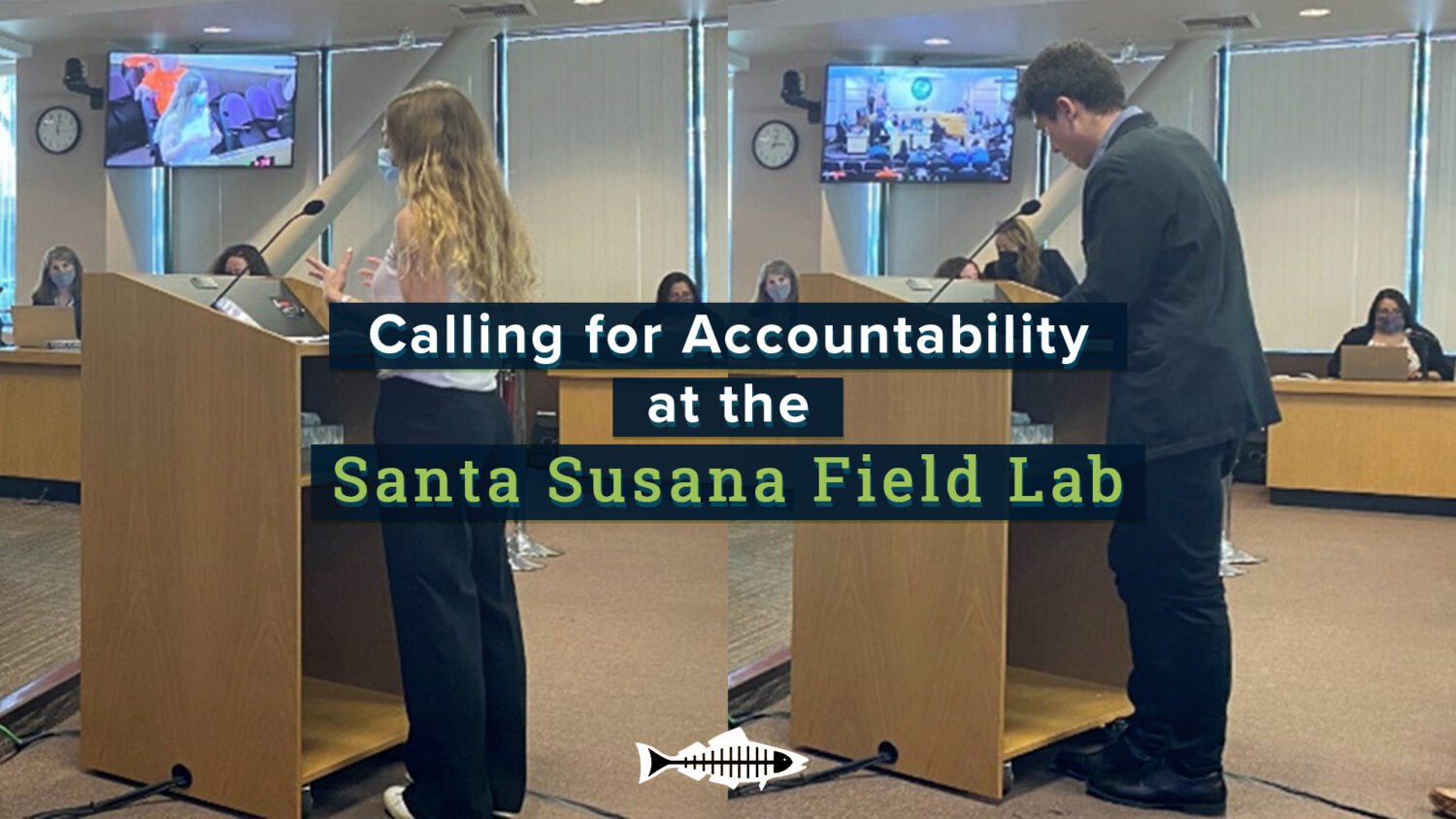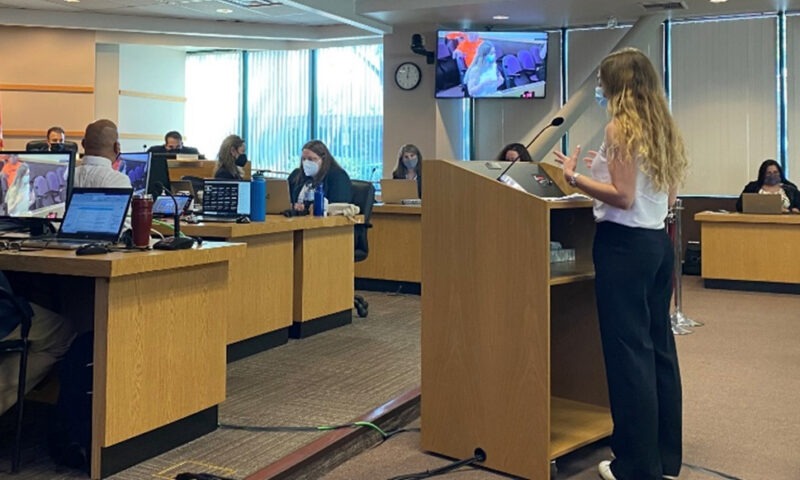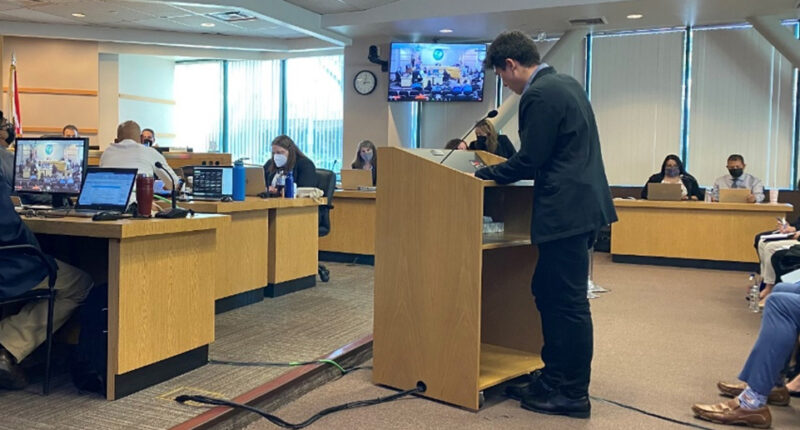Calling for Accountability at the Santa Susana Field Lab

The LA Regional Water Board approved an agreement for one of the nation’s most polluted sites. Concerns about transparency, accountability, and loopholes in this agreement leave the public vulnerable to continued contamination from the Santa Susana Field Lab.
LATEST UPDATE OCTOBER 19, 2023
We called for accountability. The Regional Board listened.
In August 2022, The Los Angeles Regional Water Board approved an agreement with Boeing to eventually consider removal of water quality regulations at their highly contaminated Santa Susana Field Lab (SSFL) site, formerly known as Rocketdyne, located in the hills above Simi Valley. This would only happen after soil cleanup has been completed, and after they have proven that surface water runoff from the site is clean. That proof of whether runoff is clean, however, depends on how well it is regulated – we don’t know what we don’t check for. The Los Angeles Regional Water Board voted today on updated regulation of runoff from SSFL, keeping the most stringent water quality limits, adding even more monitoring, and addressing the potential for surface water pollution to contaminate local groundwater through stormwater holding ponds. In this action, the Board has ensured that, if and when they consider removing regulation at this site at some future time, we can be sure that it would not happen at the expense of public and environmental health. There will also be publicly accessible quarterly reports on Boeing’s soil cleanup efforts at the site moving forward, which will help to keep Boeing accountable. Thank you to the Regional Board for using your authority to ensure protections for these lands and water resources!
UPDATE AUGUST 11, 2022
THE REGIONAL WATER QUALITY CONTROL BOARD VOTED ON AUGUST 11 to approve an agreement concerning Boeing’s highly contaminated Santa Susana Field Lab, formerly known as Rocketdyne, located in the hills above Simi Valley. The agreement sets up a process by which Boeing will eventually be able to remove its water quality regulations after cleanup has been completed, and after they have proven that runoff from the site is clean. Heal the Bay attended the 10-hour-long August 11 hearing and, while we fully support cleanup, we voiced our concerns that this agreement would not adequately protect water quality or public health and asked for a postponement to make improvements to the plan. We also raised concerns with the process — the agreement was made behind closed doors, the public was not able to submit written comments, and the only opportunity to speak was at the hearing. Due to an overwhelming turnout from members of the public, input at the hearing had to be further reduced from the typical 3 minutes to 1 minute and cut off completely at 5pm.
Both Boeing and the Regional Board claimed that this agreement was necessary for Boeing to commit to the required cleanup work, and that a delay in approval of the agreement would only delay the cleanup efforts. Stakeholders were put in an unfair position, threatened with delayed cleanup if we did not support an agreement that we had remaining concerns about. However, the blame for delays should not be placed on stakeholders and community members; these concerns and objections are not what is slowing down the process — Boeing has yet to even start a cleanup that was supposed to be completed back in 2017. As community member Marie Mason mentioned to me at the hearing, “If Boeing wanted to do the right thing, they would have done it 20 years ago,” and could have avoided the impacts of pollution and contamination exposure during that time. Further, the cleanup plan itself also raised concerns (see more on this in the next section) and while the decision before the Board was not specifically on the cleanup plan, the cleanup and the agreement are inextricably linked, and approval of the agreement meant a de facto approval of the cleanup plan.
Despite the overwhelming call for either a no vote or a delay, the Board unanimously approved the agreement, with minor edits. Heal the Bay will remain engaged on this issue because the bottom line is that cleanup to a level that is fully protective of human and ecological health needs to happen as soon as possible.
The history of contamination at the Santa Susana Field Lab
Boeing, NASA, and the Department of Energy own the Santa Susana Field Lab (SSFL) site, where industrial activities were conducted from 1949 to 2006 to test rocket engines and nuclear reactors. This site contains high levels of contamination from these past activities, which have negatively affected the ecosystem, the groundwater, and the surface water that runs off the site, as well as the communities that rely on those water resources. Additionally, SSFL is located on top of a hill, which means that runoff from the site flows downhill into the community to the north in Simi Valley, feeds into the headwaters of the Arroyo Simi waterway, and feeds into theheadwaters of the Los Angeles River. Contamination from this site affects the entire LA Region, but the impacts are felt most severely in local communities.
In 2007, the California Department of Toxic Substances Control (DTSC) set requirements to fully clean up the contaminated soils at SSFL by 2017. But after decades of litigation and delays (led by Boeing), we are now five years after that deadline, and the cleanup has barely even begun. The longer we wait for Boeing to clean up their mess, the longer our ecosystems and communities are exposed to the contamination. In fact, the 2018 Woolsey fire remobilized existing contamination, leading to 57 distinct surface water violations in a single wet season. Had the cleanup been completed by 2017, as originally required, these violations would not have occurred. To add insult to injury, nearly all of Boeing’s fines associated with those violations were waived. Members of the community are the ones paying the price. According to a study by epidemiologist Hal Morgenstern of the University of Michigan, “the incidence rate [of cancer] was more than 60% greater among residents living within 2 miles of SSFL than among residents living more than 5 miles from SSFL.”
To avoid additional delays, CalEPA announced in May 2022 that a new cleanup settlement had been negotiated over the past several years between DTSC and Boeing, with an agreement that Boeing would not sue over this one. However, with no opportunity for public engagement, or even public comment, stakeholders have been left with so much uncertainty surrounding the new cleanup requirements. Community groups, non-governmental organizations, and even municipal legal consultants have reviewed the final cleanup agreement. These expert reviews have revealed a number of contamination limits altered in the latest version, and there is uncertainty on whether these changes are based on the best available science.
The agreement between Boeing and the Regional Board
The LA Regional Water Quality Control Board, which regulates only the surface water runoff at this site, drafted an agreement (also known as a Memorandum of Understanding or MOU) with Boeing to outline how Boeing can eventually remove its water quality regulations. The MOU requires Boeing to complete the soil cleanup as required by DTSC, and conduct modeling and monitoring to prove that surface water runoff is clean. The Regional Board believes that this MOU provides an extra safety measure, setting additional milestones to protect surface water quality, even if the cleanup agreement is flawed.
Although we agree with this in theory, the MOU can only offer this type of reinforcement for surface water quality protection if significant changes were made to the agreement language. Unfortunately, the Regional Board offered no opportunity for written comment on the MOU. Luckily, Heal the Bay was able to attend the hearing in person and provide our full statement in writing to the Board members, even if our verbal comments were cut short.
Heal the Bay’s Recommendations to improve the Santa Susana Field Lab MOU
- To address remaining concerns about the agreement, we asked the Regional Board to commit to providing a period for written public comments on the monitoring program to show whether surface water runoff is clean.
- We recommended that the MOU must ensure regulation of past industrial activity, not just of future construction activity.
- While the MOU had the potential to provide assurances for protection of surface water, the potential was not there for groundwater. We urged the Regional Board to reclaim regulatory authority of groundwater to ensure that the long-term quality of both surface water and groundwater at this site were sufficiently protective of human and ecological health.
- If buried contaminated soil is left behind under the DTSC cleanup requirements, an earthquake or another fire followed by flooding could re-mobilize buried contamination. We demanded that the MOU include a statement to ensure that the responsible parties would have to address any and all remaining contaminated soil so long as they pose a risk to human or ecological health.
 “This MOU is an opportunity to provide a backstop to protect surface water quality even if there are flaws in the cleanup agreement. However, the MOU can only offer this type of reinforcement if some changes are made… To ensure that our concerns are addressed, we request that the Regional Board commit now, within the language of the MOU, to providing a period for written public comments on the monitoring program.”
“This MOU is an opportunity to provide a backstop to protect surface water quality even if there are flaws in the cleanup agreement. However, the MOU can only offer this type of reinforcement if some changes are made… To ensure that our concerns are addressed, we request that the Regional Board commit now, within the language of the MOU, to providing a period for written public comments on the monitoring program.”
– Elana Nager, Heal the Bay
Heal the Bay Policy Intern, Elana Nager, provides public testimony at the August 11, 2022 Hearing of the Los Angeles Regional Water Quality Control Board concerning the Santa Susana Field Lab Memorandum of Understanding.
In response to Heal the Bay’s comments, the Regional Board did commit to our recommendation #1, to provide a period for written public comments on the monitoring program — a program that will determine whether the cleanup was successful. We have remaining concerns about how rigorous that monitoring program will be, but by securing a public review we will at least get the chance to address those concerns later on.
Additionally, in response to pressure from Heal the Bay and a community-based coalition (including Parents against Santa Susana Field Lab, Physicians for Social Responsibility, Committee to Bridge the Gap, and Public Employees for Environmental Responsibility), the Regional Board took our recommendation #2 and removed one small word – “or” – from the agreement. This small change will require permit coverage for stormwater discharges associated with past industrial activity, and permit coverage for stormwater discharges associated with construction, as needed for any future cleanup activity. Originally, permit coverage could have only addressed construction activity, which would have been insufficient.

“We request that the ‘or’ in this statement be removed… Coverage must be specifically related to past industrial activity. One word makes a world of a difference.”
– Prince Takano, Heal the Bay
Heal the Bay Policy Intern, Prince Takano, provides public testimony at the August 11, 2022 Hearing of the Los Angeles Regional Water Quality Control Board concerning the Santa Susana Field Lab Memorandum of Understanding.
Although Board Member Christiansen attempted to include provisions for all of Heal the Bay’s recommendations, our two biggest concerns about re-mobilization of contaminated soil and pollution of groundwater were ultimately left unaddressed. In fact, when the Regional Board asked DTSC to address these concerns, DTSC Director Williams responded simply that groundwater will be monitored, and that the geology at this site is complicated. There was no additional discussion.
Even with the severely limited public process, significant remaining concerns, and the hundreds of voices asking for a either a no vote or a delay (including surprising testimony from former Regional Board Chair Lawrence Yee, who attended as a member of the public to ask the Board to reject the agreement), the Regional Board unanimously approved the MOU, with minor edits.
Where do we go from here?
The few small changes to the MOU do ensure a better public process moving forward, but do not ensure that this MOU will protect surface water quality or public health. However, we might have another chance to hold Boeing accountable for contaminated surface water runoff through their current water quality regulations (or discharge permit), which is up for renewal right now and will be upheld until cleanup is complete and they have proven that surface runoff is clean. There will be another Regional Board meeting later this year to discuss that permit. Heal the Bay will be there advocating for a strong permit that is protective of water quality not only in runoff from the site, but also runoff on the site, which can infiltrate into the ground and further contaminate the soils and groundwater. Stay tuned for more information about that meeting, and how you can join Heal the Bay to hold Boeing accountable.
ACTION LINK(S)
EDITOR NOTE: Since the publishing of this blog post, the Regional Board has reached out to Heal the Bay to clarify that the reduced speaking time offered during the hearing was a direct result of the unusually large turnout from members of the public. The article has been updated to acknowledge these conditions.
Written by Annelisa Moe. As a Heal the Bay Water Quality Scientist, Annelisa helps to keep L.A. water clean and safe by advocating for comprehensive and science-based water quality regulation and enforcement. Before joining the team at Heal the Bay, she worked with the Regional Water Quality Control Board in both the underground storage tank program and the surface water ambient monitoring program.



